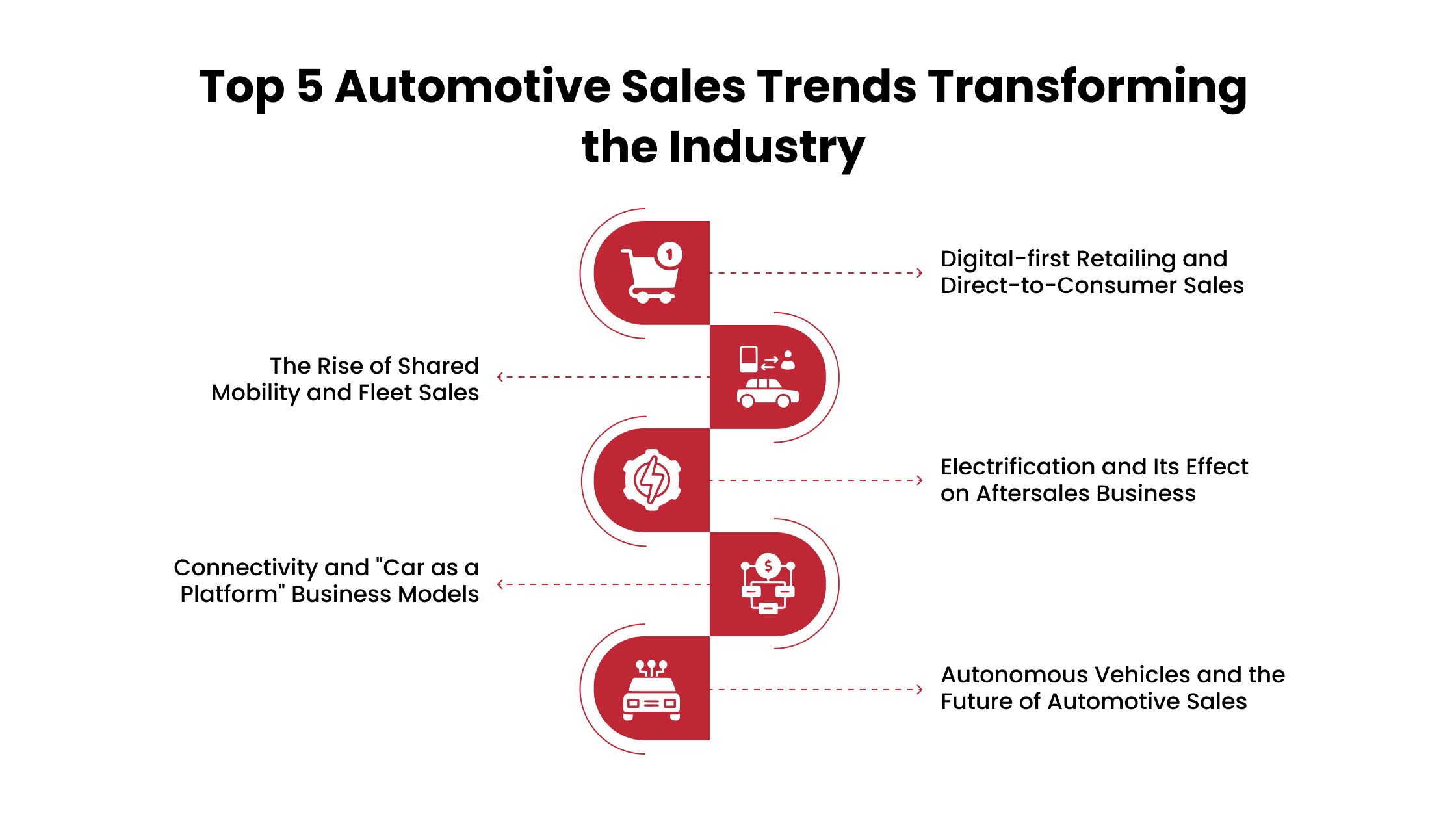5 Automotive Sales Trends Transforming the Automotive Industry

Dealerships have thrived on a simple model: foot traffic, test drives, and handshake deals. But by 2035, private cars will make up just 29% of global transportation modes, down from 45% in 2022. Consumers are rethinking ownership, digital channels dominate the buying journey, and EVs are rewriting service revenue streams.
Here’s the hard truth: the conventional dealership model isn’t built for the future that’s coming. The real question isn’t whether the industry will change—who will adapt and succeed with it.
The best-performing dealers will sell more than cars; they will also sell convenience, mobility, and a seamless, tech-driven experience.
So, what are the trends shaping the future of automotive sales? Let’s break it down.
Top 5 Automotive Sales Trends Transforming the Industry

To remain competitive, dealerships must adapt, utilizing new strategies prioritizing digital engagement, flexible ownership models, and data-driven decision-making. Here are five major trends redefining automotive sales and dealership success.
1. Digital-First Retailing and Direct-to-Consumer Sales
The days of customers spending hours at a dealership negotiating prices and filling out paperwork are fading fast. Today’s buyers expect a seamless, digital-first experience—one that mirrors the convenience of online shopping. According to a study, nearly 30% of all consumers desire to make their next vehicle purchase online, with 34% of Gen Z respondents indicating a willingness to entirely order their next vehicle online without any physical dealership touchpoints.
This shift has given rise to direct-to-consumer (DTC) sales models pioneered by EV manufacturers like Tesla and Rivian. While regular dealerships still play a vital role, success now depends on integrating digital tools that allow customers to research, configure, and even purchase vehicles online. Major strategies include:
- Omnichannel experiences – A seamless transition between online and in-person interactions.
- AI-driven chatbots and virtual assistants – Enhancing lead generation and customer support.
- Digital financing and e-signatures – Streamlining paperwork and approvals.
- At-home test drives and delivery options – Redefining convenience for customers.
For dealerships, adapting to this trend means investing in digital retailing solutions and rethinking their approach to customer engagement—meeting buyers where they are rather than waiting for them to walk through the door.
2. The Rise of Shared Mobility and Fleet Sales
Car ownership isn’t the only option in town anymore. Consumers increasingly embrace ride-hailing, car-sharing, and vehicle subscription models, shifting the demand away from individual purchases toward fleet sales. This isn’t a decline for dealerships—it’s a strategic pivot.
Fleet operators, including ride-hailing services, corporate mobility programs, and last-mile delivery companies, purchase vehicles at scale. This presents a lucrative opportunity for dealerships that can adapt to the changing landscape. Success in this space means:
- Building strong relationships with fleet buyers – Understanding their operational needs and offering customized solutions.
- Providing flexible financing and leasing options – Helping businesses scale their fleets without heavy upfront costs.
- Enhancing after-sales support – Prioritizing maintenance packages and quick service turnarounds to keep fleet vehicles on the road.
Rather than viewing shared mobility as a threat, forward-thinking dealerships integrate fleet sales into their core sales strategy, ensuring they remain relevant in a world where access often trumps ownership.
3. Electrification and Its Effect on After-sales Business
The shift toward electric vehicles (EVs) isn’t just changing what consumers drive—it’s redefining the entire aftersales market. With fewer moving parts, no oil changes, and regenerative braking reducing wear and tear, EVs require significantly less routine maintenance than traditional internal combustion engine (ICE) vehicles. For dealerships, this signals a significant shift in service revenue streams.
However, adaptation creates opportunity. The dealerships that thrive in an EV-dominated market will:
- Prioritize high-value services – Battery diagnostics, software updates, and specialized repairs will replace traditional maintenance as major revenue drivers.
- Invest in technician training – Certified EV specialists will be essential to providing the expertise customers demand.
- Expand charging solutions – Offering in-house charging infrastructure and partnerships with charging networks can enhance dealership value.
Dealerships that position themselves as EV service hubs will maintain customer loyalty and drive new revenue through value-added services.
4. Connectivity and "Car as a Platform" Business Models
Modern vehicles are no longer just modes of transportation—they are data-rich, connected platforms that unlock new revenue opportunities for dealerships. With built-in telematics, over-the-air (OTA) software updates, and personalized in-car experiences, connectivity is reshaping how consumers interact with their vehicles.
For dealerships, this trend presents several lucrative opportunities:
- Subscription-Based Services – From premium navigation and advanced driver assistance features to entertainment packages, dealerships can tap into recurring revenue streams by offering and managing digital subscriptions.
- Predictive Maintenance & Remote Diagnostics – Real-time vehicle monitoring allows dealerships to proactively address maintenance needs, enhancing customer trust and driving service appointments.
- Personalized Sales & Upselling – Connected vehicles generate valuable driving habits and preferences data, enabling hyper-personalized offers on accessories, upgrades, and even new models.
Dealerships that embrace the "Car as a Platform" model will increase customer engagement and future-proof their business against shifting industry dynamics.
5. Autonomous Vehicles and the Future of Automotive Sales
The road to autonomous driving is advancing rapidly. While fully self-driving cars may still be years away from mass adoption, their impact on automotive sales is already taking shape. As automation advances, consumer preferences and ownership models will shift, presenting challenges and opportunities for dealerships.
Significant implications for dealerships include:
- Fleet-Centric Sales Growth – Autonomous vehicles (AVs) are expected to thrive in ride-hailing, delivery, and corporate fleets before becoming mainstream for individual buyers. This means dealerships must strengthen relationships with fleet operators and explore new financing and service models.
- Redefined Service & Maintenance – With AVs relying on sophisticated sensors, AI-driven diagnostics, and minimal driver intervention, conventional service intervals may change. Dealerships must invest in advanced repair capabilities and technician training to stay relevant.
- Changing Consumer Buying Behaviors—Some consumers may prioritize on-demand access over ownership as shared mobility and autonomous transportation services grow. Dealerships should prepare for a future where car sales could shift toward flexible leasing and subscription-based ownership models.
While AVs introduce uncertainty, they also create new pathways for growth. Dealerships that adapt to fleet sales, connectivity-driven service models, and evolving ownership preferences will be best positioned for long-term success.
Future-Proof Your Dealership with Automotive Training Network

The automotive industry is growing rapidly, and dealerships that embrace change will lead the pack. From digital-first retail to the rise of fleet sales and autonomous vehicles, staying ahead requires more than just keeping up—it demands proactive learning and strategic execution.
Here’s how Automotive Training Network can help your dealership ride this transformation:
- Digital Sales Mastery – Train your team to excel in online retailing and direct-to-consumer sales.
- Fleet & Shared Mobility Strategies – Optimize your approach to high-volume fleet and corporate accounts.
- EV Service & Sales Readiness – Adapt your dealership’s operations for the growing electric vehicle market.
- Maximizing Connectivity Revenue – Leverage in-car technology to create new profit opportunities.
- Future-Proofed Training for AVs – Prepare your team for autonomous vehicle sales and service models.
Don’t just react to change—lead it. Contact Automotive Training Network today and equip your dealership with the skills, strategies, and tools needed to thrive in the future of automotive sales.
Frequently Asked Questions
1. What are the five forces shaping the automotive industry?
The automotive industry operates under Porter’s Five Forces framework:
- Supplier Power – Semiconductor shortages and battery production constraints have given suppliers more leverage over pricing and availability.
- Intensity of Rivalry – Traditional OEMs, tech disruptors, and startups are competing fiercely for market share, driving innovation and aggressive pricing.
- Barriers to Entry – High capital investment, regulatory requirements, and supply chain complexities make it difficult for new players to enter.
- Buyer Power – Consumers have more choices, access to transparent pricing, and digital purchasing options, increasing their influence over dealerships.
- Threat of Substitutes – The rise of shared mobility, ride-hailing, and subscription-based vehicle ownership challenges traditional car sales models.
2. Which major trend is currently transforming automotive sales?
Digital-first retailing is one of the most significant trends. Consumers now expect seamless online experiences, from researching vehicles to finalizing purchases. To stay ahead, dealerships must integrate e-commerce, AI-driven recommendations, and digital financing solutions.
3. How is electrification reshaping the automotive sales landscape?
EVs are redefining traditional dealership operations, requiring new expertise in battery technology, charging infrastructure partnerships, and software-driven vehicle maintenance. Additionally, aftersales revenue models are shifting away from engine repairs to software updates and battery diagnostics.
4. What role does connectivity play in modern automotive business models?
Connectivity is transforming cars into digital platforms, allowing for:
- Subscription-based features (e.g., navigation, performance upgrades)
- Remote diagnostics and predictive maintenance
- Over-the-air software updates
- Personalized in-car experiences and data-driven services
5. How should dealerships prepare for the shift toward autonomous vehicles?
While fully autonomous vehicles are still evolving, dealerships can stay ahead by:
- Training staff on AV technology and safety features
- Offering maintenance services for ADAS-equipped vehicles
- Partnering with AV developers and fleet operators
- Exploring mobility-as-a-service (MaaS) business models
